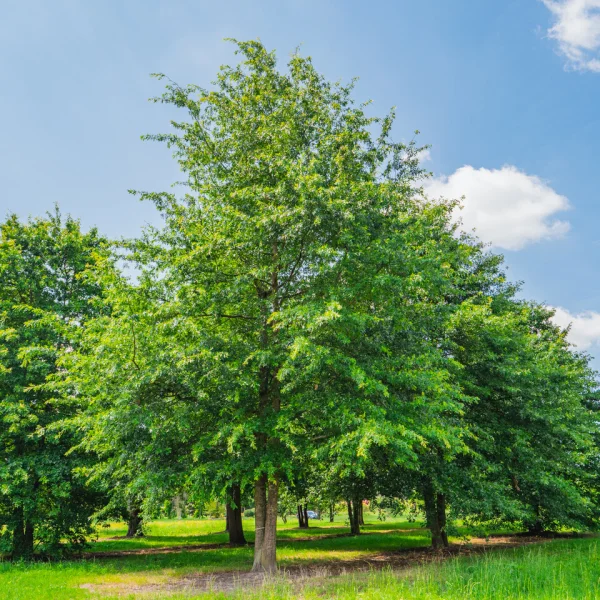Quercus ellipsoidalis – Northern pin oak, Hill's oak
Fagaceae
Quercus ellipsoidalis – Northern pin oak, Hill's oak
Un stejar foarte asemănător cu Q. palustris, care crește în mod natural în partea de nord-est a Statelor Unite. Formează acolo un arbore substanțial, cu o coroană ovoidală largă, care ajunge la aproximativ 25 m înălțime. În cultură, nu mai înalt de aproximativ 15 m. Canelurile puțin adânci din scoarța cenușie sunt galbene. Din acest motiv, copacul mai este numit și "stejar galben". Frunza ovoidală este profund lobată cu pene. Lobii sunt ascuțiți și puternic dințoși. Frunza este de un verde strălucitor, verde deschis pe dedesubt și devine purpurie închisă toamna. Ghindele mari de 1 până la 2 cm sunt eliptice și sunt cuprinse între o treime și o jumătate de nap. Aceasta este principala diferență față de Q. palustris, ale cărui ghinde sunt rotunde până la aplatizate și închise de la o treime până la un sfert.
Availability
Specifications
Download PDF
Height
8 - 15 (25) m
Width
8-15m
Crown
broad ovoid, half-open crown
Bark and branches
greyish-brown, bark fissured, young twigs olive coloured
Leaf
ovoid to elongated, deep pinnately lobed, dark green, 8 - 14 cm
Autumn colour
red, purple
Flowers
gold coloured ♂ catkins, 7 - 10 cm long, May
Fruits
acorns 1 - 2 cm in size, elliptical
Spines/thorns
None
Toxicity
usually not toxic to people, (large) pets and livestock
Soil type
preferably calcareous
Soil moisture
suitable for wet soil
Paving
tolerates no paving
Winter hardiness zone
4 (-34,4 to -28,9 °C)
Wind resistance
good
Other resistances
resistant to frost (WH 1 - 6), can withstand wind, resistant to de-icing salt
Application
avenues and broad streets, industrial areas
Shape
clearstem tree, multi-stem treem
Origin
north-east of North America
Possibly of interest
Frequently asked questions
Quercus ellipsoidalis
Quercus ellipsoidalis can eventually reach a height of 8 - 15 (25) m, depending on the site and climate conditions.
Quercus ellipsoidalis has a average growing and can eventually reach a height of 8 - 15 (25) m, depending on the site and climate conditions.
The leaves of Quercus ellipsoidalis turn red, purple in autumn.
The right time to plant Quercus ellipsoidalis is during the dormancy period. In Western Europe, Quercus ellipsoidalis with root balls can generally be planted from mid-November to late April, although this depends strongly on the climatic conditions and the species of tree.
may.
General
 English
English
 English (United Kingdom)
English (United Kingdom)
 Nederlands
Nederlands
 Nederlands (België)
Nederlands (België)
 Deutsch
Deutsch
 français
français
 čeština
čeština
 polski
polski
 español
español
 română
română
 dansk
dansk
 svenska
svenska
 magyar
magyar
 Türkçe
Türkçe
 slovenčina
slovenčina
 русский
русский
 norsk
norsk







